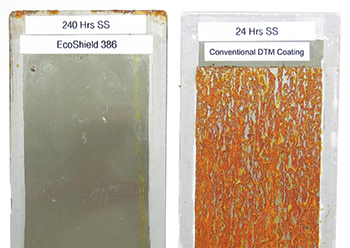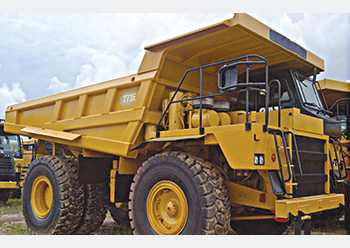Cortec offers ‘green’ corrosion protection
01 January 2020
US-based Cortec says its water-based VpCI-386 for outdoor corrosion protection provides a good alternative to solvent-based corrosion inhibitor coatings.
The fast-drying, water-based acrylic one-coat system (topcoat) can be applied direct to metal (DTM) for corrosion protection in outdoor unsheltered applications, offering a variety of environmental and user benefits.
“VpCI-386 has relatively low volatile organic compounds (VOC) of 72 g per litre, well below the typical cut-off of 419 g per litre for VOC compliance in many regions,” a spokesman for Cortec points out.
 |
|
VpCI-386 ... superior corrosion protection. |
As a water-based product, VpCI-386 is able to compete with many paints and zinc-rich coatings, thanks to the power of Cortec’s ‘Nano’ VpCI inhibitors, he says.
“These inhibitors fight micro-corrosion by forming a molecular protective layer that follows the intricacies of the substrate’s micro-cavities. This offers fuller inhibitor coverage than traditional sacrificial metal inhibitors, which leave gaps due to their relatively large particle sizes. Implementing VpCI-386 allows users to the lower environmental impact by reducing VOCs while also minimising worker exposure to solvents and making coating clean-up easier,” he explains.
VpCI-386 is adaptable to a variety of applications, apart from DTM. It can also be applied as a clear coat on top of another coating, creating minimal change to surface appearance.
This was beneficial for a Pacific military base that wanted to protect airfield damage repair vehicles that were sitting in very corrosive conditions near the ocean. In another case, an Indonesian dealer of heavy equipment applied VpCI-386 Black and CAT Yellow to maintain the vehicles’ appearance while providing corrosion protection in a seaside storage yard after the conventional paint failed to provide the desired solution.
After three months, VpCI-386 had outperformed the conventional paint on tested areas, so the customer decided to do a full paint job on the equipment bodies using the custom-tinted VpCI-386 coatings, the spokesman adds.
As a permanent coating that can be welded over, VpCI-386 does not need to be removed before final instalment or use of the protected metal components. Although it is ideal to apply VpCI-386 at the manufacturing site from the outset, it can also be applied farther down the line to protect expensive metal assets that will sit for extended periods at storage sites.
This was the case at a power plant being built in the southern US in a corrosive environment of temperature and humidity swings. Custom-built smokestack sections from Asia had been delivered to the site almost two years ahead of time. VpCI-386 was used to coat the ID (inner diameter) of the smokestack sections for interim protection in order to avoid construction delays. The coating met their needs for a product that was easy to apply and did not need to be removed upon installation.
“VpCI-386 is an excellent option for industries needing a water-based corrosion inhibitor coating. In addition to its corrosion protection benefits, VpCI-386 minimises changes to surface appearance, reduces VOCs, and minimises worker exposure to solvents to present an overall friendlier profile for users and the environment,” the spokesman says.
For areas that require temporary corrosion protection, Cortec offers VpCI-391, a water-based removable coating that is non-tacky and leaves behind a virtually unnoticeable thin dry film to protect both painted and unpainted surfaces.
“VpCI-391 has become a popular coating for use where temporary corrosion protection is needed on newly manufactured industrial vehicles and equipment such as firetrucks, earthmovers, and other high-value assets such as those made for the oil and gas industry,” he says.
Typical uses include protection of heavy equipment, machinery, vehicles, piping and structural steel.
Temporary corrosion protection is often needed during periods of transit or storage in order to keep metal components in good condition until the time they are actually needed. In the past, one approach to corrosion protection has been to apply petroleum-based coatings that leave behind a wax-like film that is often effective but difficult to remove.
“VpCI-391 is an excellent example of how Cortec has designed an alternative that is better for both the environment and users: it is water-based, low VOC (48 g per litre) and easy to remove with an alkaline wash, if needed,” the spokesman says.
VpCI-391 has been found to be a useful option especially as a transit coating, allowing users to spray VpCI-391 as a clear coat right over corrosion-prone components of heavy equipment – lug nuts, dissimilar metal components, keyholes, bolt threads, etc – without significantly changing the appearance. Testing of VpCI-391 has found that use of the coating on weld joints does not negatively impact weld geometry or mechanical properties of the weld, making it a good choice for keeping surfaces corrosion-free prior to welding – whether or not the welder decides to remove the coating before going to work, he concludes.
- Coatings sector gets its own Siri
- Asian Paints Berger launches new emulsion
- Cortec offers ‘green’ corrosion protection
- Finnester’s composite coating scores a first



